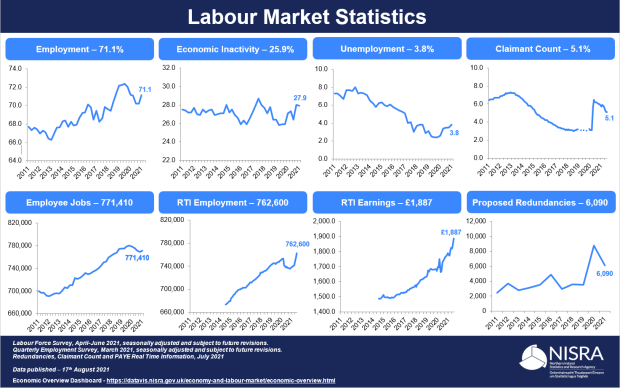Labour Market Report August 2021
Date published:
Latest labour market statistics
The latest Labour Force Survey (LFS) estimates relate to April-June 2021 and indicate that, over the quarter, the employment rate increased, the economic inactivity rate decreased and the unemployment rate increased.
The labour market statistics were published today by the Northern Ireland Statistics & Research Agency.

July’s proposed redundancies highest of 2021
- 850 redundancies were proposed during July 2021, taking the total number of proposed collective redundancies in the last twelve months to 6,090, nearly a third less than the number recorded in the previous twelve months (8,790).
- During July 2021, 250 redundancies were confirmed, taking the annual total to 5,750. This annual total was 81% higher than in the previous year (3,180).
NI Claimant Count (Experimental Series) decreased for the fifth consecutive month
- In July 2021, the seasonally adjusted number of people on the claimant count was 50,000 (5.1% of the workforce), which is a decrease of 800 (1.5%) from the previous month’s revised figure. The July claimant count is 22% below the recent peak in May 2020, and 64% higher than the pre-pandemic count in March 2020.
Payrolled employees now higher than pre-COVID for the second consecutive month
- The number of employees receiving pay through HMRC PAYE in NI in July 2021 was 762,600, an increase of 1.1% over the month and 3.1% over the year. This is the highest on record and the second consecutive month that employee numbers were above pre-COVID levels.
- Earnings from the HMRC PAYE indicated that NI employees had a median monthly pay of £1,887 in July 2021, an increase of £39 (2.1%) over the month and £148 (8.5%) over the year.
The unemployment rate increased over the quarter and over the year
- The latest NI seasonally adjusted unemployment rate (the proportion of economically active people aged 16+ who were unemployed) for the period April-June 2021 was estimated from the Labour Force Survey at 3.8%. The unemployment rate increased by 0.4 percentage points (pps) over the quarter and increased by 1.2pps over the year. The annual change was statistically significant and likely to reflect real change.
- The proportion of people aged 16 to 64 in work (the employment rate) increased over the quarter by 0.9pps and was unchanged over the year at 71.1%. Neither the quarterly nor annual changes were statistically significant.
- The economic inactivity rate (the proportion of people aged 16 to 64 who were not working and not seeking or available to work) decreased over the quarter by 1.3pps and over the year by 0.9pps to 25.9%. Neither the quarterly nor annual changes were statistically significant.
- Put into the context of the UK, NI had the second lowest unemployment rate, the lowest employment rate and the highest economic inactivity rate of all the UK regions.
The statistical bulletin and associated tables are available on the Labour Market Report - August 2021 page.